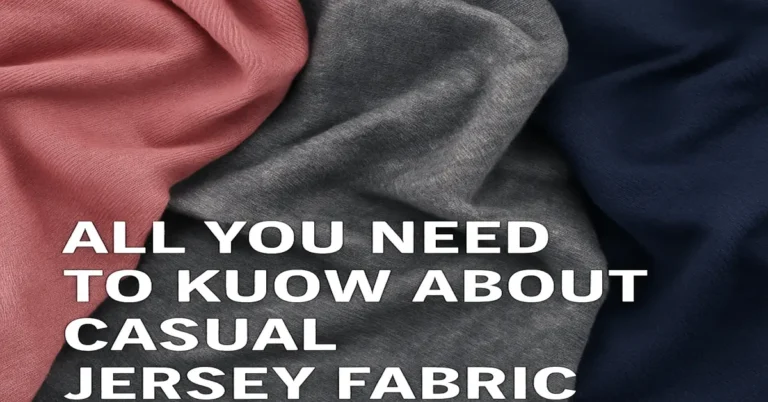14 Types of Socks Explained Trending in 2025
Socks come in many styles, lengths, and materials, each designed to meet different needs and preferences. People wear various types depending on comfort, activity, and fashion.
Knowing the different types of socks helps people choose the right pair for every occasion and improve their overall comfort. Understanding these options makes it easier to find socks that work well with specific shoes and activities
1) No-Show Socks

No-show socks are designed to be hidden inside shoes. They stay below the shoe line, so they are not visible when worn. This makes them popular for people who want the comfort of socks without the look of wearing any.
These socks are often called loafer socks because they work well with loafers and other low-cut shoes. They are made to fit snugly on the foot, preventing slipping and bunching. Both men and women wear no-show socks for a clean, minimalist style.
No-show socks are usually made from soft, breathable materials like cotton blended with spandex. This mix helps keep feet cool and comfortable all day. High-quality options hold their shape and stretch even after many washes.
They are great for casual and athletic shoes, providing protection from blisters and sweat without cluttering the shoe’s appearance. Because they do not cover the ankle, they are not ideal for cold weather but work well in warmer seasons.
2) Ankle Socks
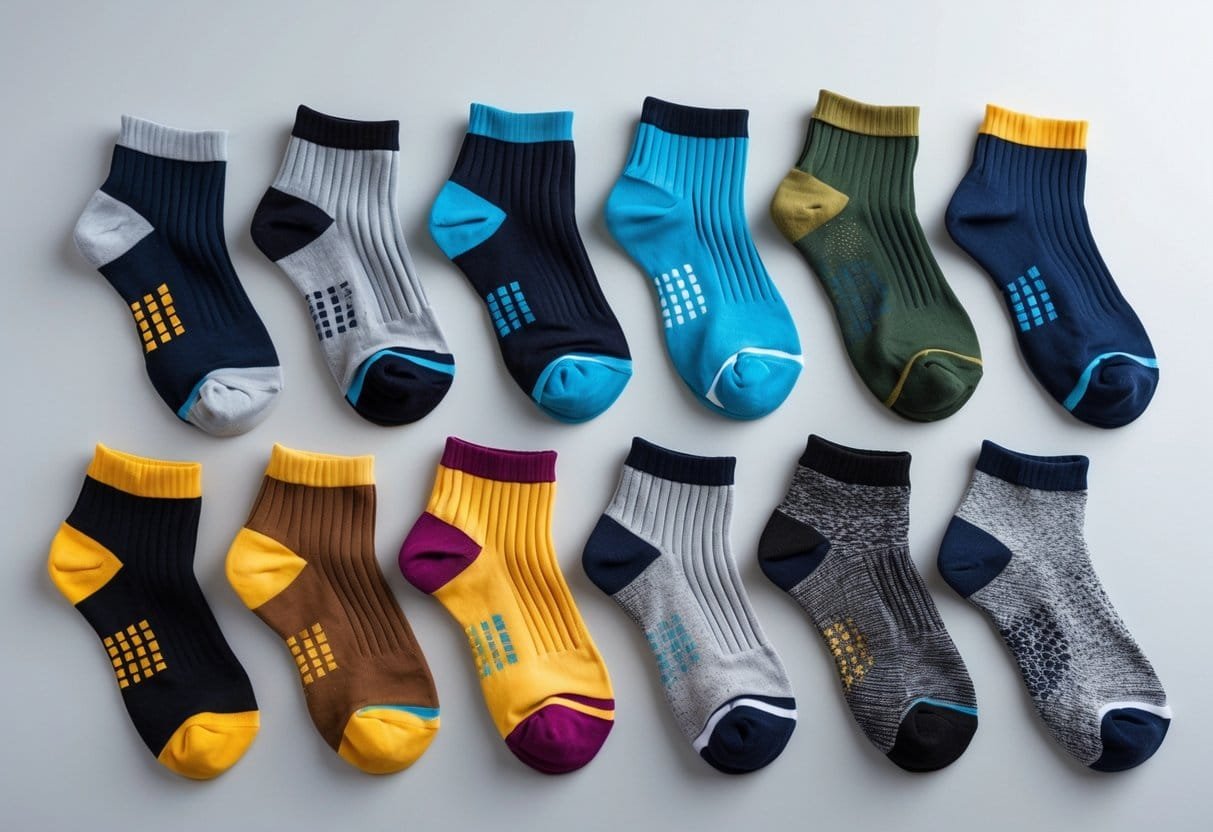
Ankle socks are a popular choice for everyday wear. They reach just above the ankle bone, making them a good match for sneakers and casual shoes. Because they are short, they stay hidden under most pants and shoes.
These socks are often made from cotton or synthetic fabrics. This helps keep feet dry and comfortable. They work well for light activities like walking or running errands.
Ankle socks also provide a little protection against rubbing or blisters. They cover the heel and the sole but leave the lower shin bare. This makes them cooler than crew or knee-high socks in warm weather.
People often pick ankle socks for gym workouts or casual outings. They balance coverage and breathability without being too bulky. Their style fits well with sporty and casual looks alike.
3) Crew Socks
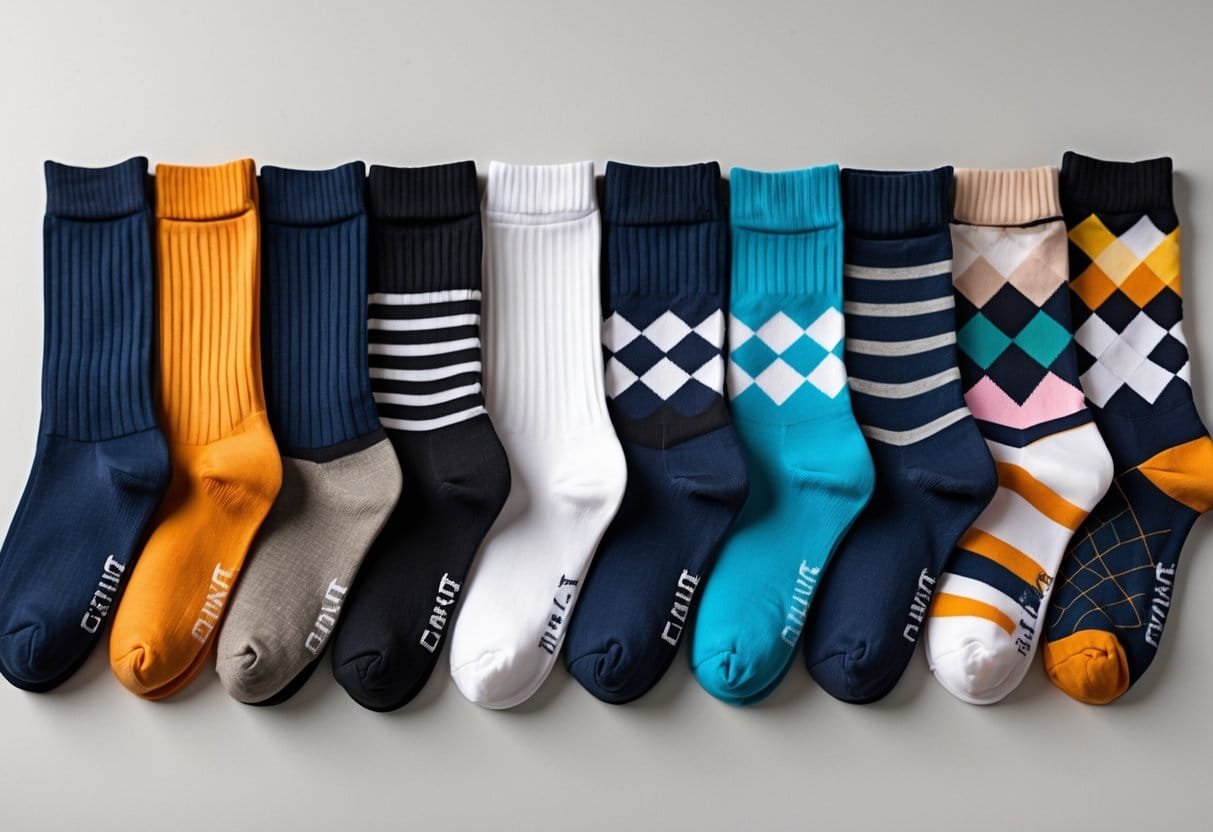
Crew socks are one of the most popular and versatile types of socks. They usually reach the mid-calf area, making them longer than ankle socks but shorter than knee-high socks. This length works well with many kinds of shoes, including boots and casual sneakers.
They come in many materials like cotton, wool, and synthetic blends. This allows people to choose options for comfort, warmth, or moisture control. Crew socks can be plain or feature patterns and colors, making them suitable for both everyday wear and casual fashion.
Because of their moderate length, crew socks provide good coverage and support. They protect the lower leg and help prevent chafing when worn with boots. This makes them popular for sports, work, and outdoor activities. Crew socks are also easy to find and come in a wide range of styles, fitting many needs without much effort.
4) Mid-Calf Socks
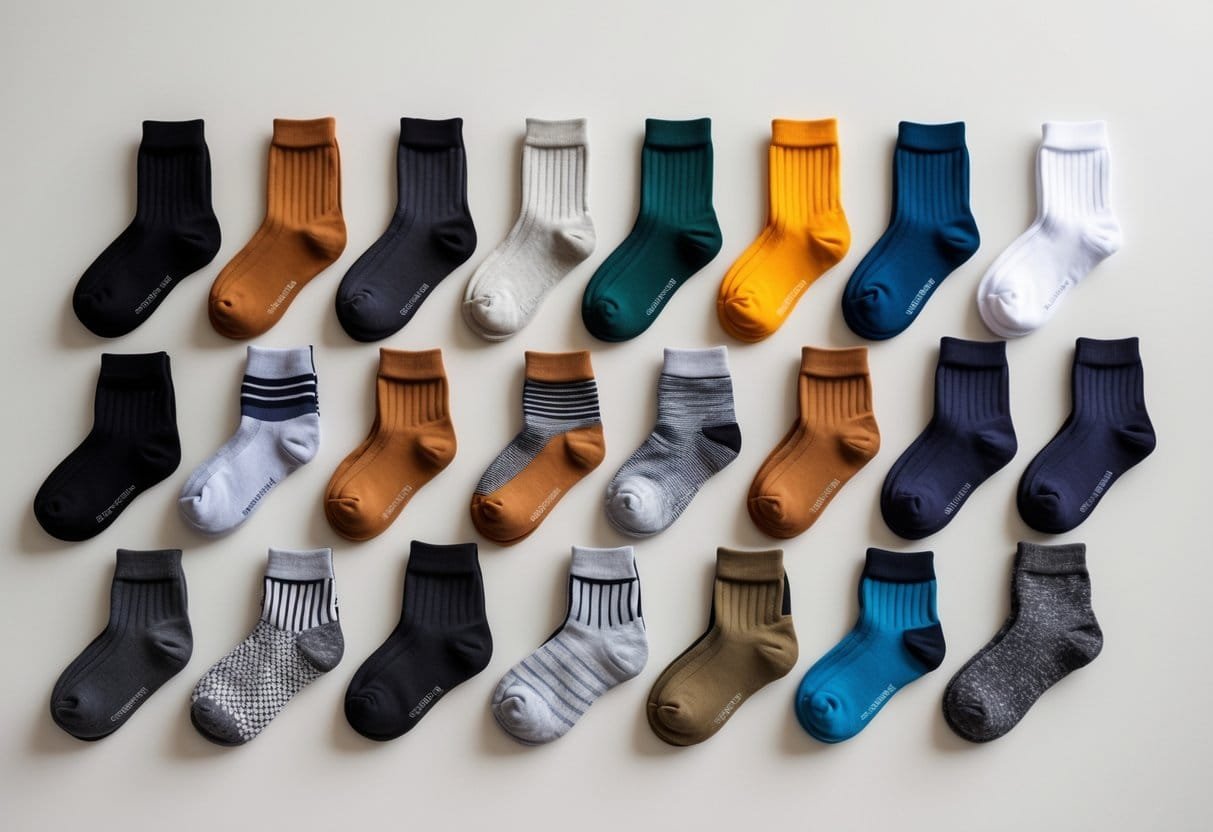
Mid-calf socks reach about halfway between the ankle and the knee. This length is one of the most common and versatile choices. Many people wear them for casual, dress, and athletic purposes.
They provide good coverage and warmth without being too long. Mid-calf socks work well with boots and most shoes. They help protect the lower leg while keeping feet comfortable.
These socks come in many materials like cotton, wool, and synthetic blends. Wool mid-calf socks are popular for cooler weather because they keep feet warm and dry. Cotton is a good everyday option for breathability.
Mid-calf socks often fit well under pants and don’t slide down easily. This makes them a reliable choice for long days, whether at work or during sports. The length also offers some protection against chafing from boots or shoes.
5) Over-the-Calf Socks
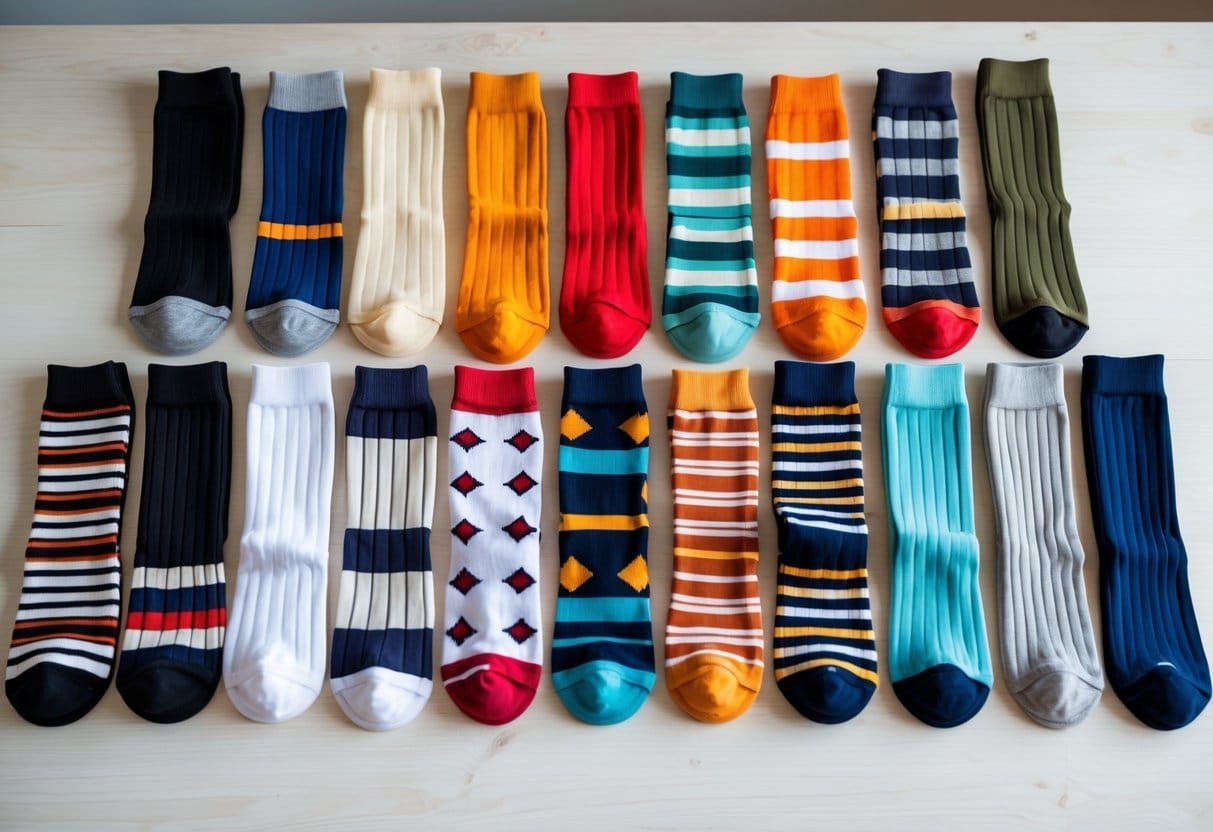
Over-the-calf socks are long socks that reach just below the knee. They provide full coverage of the lower leg, making them ideal for cold weather or formal occasions where a neat appearance is important.
These socks offer extra warmth and support compared to shorter styles. Many people choose them for activities like skiing or for wearing with dress shoes to avoid showing any skin when sitting or crossing legs.
Because they stay up without slipping, over-the-calf socks are preferred for all-day wear. They also help protect the leg from chafing when wearing boots or tight shoes.
While heavier materials are common for warmth, these socks also come in thinner fabrics suited for office or formal wear. Their length and fit make them a versatile choice for both function and style.
6) Knee-High Socks
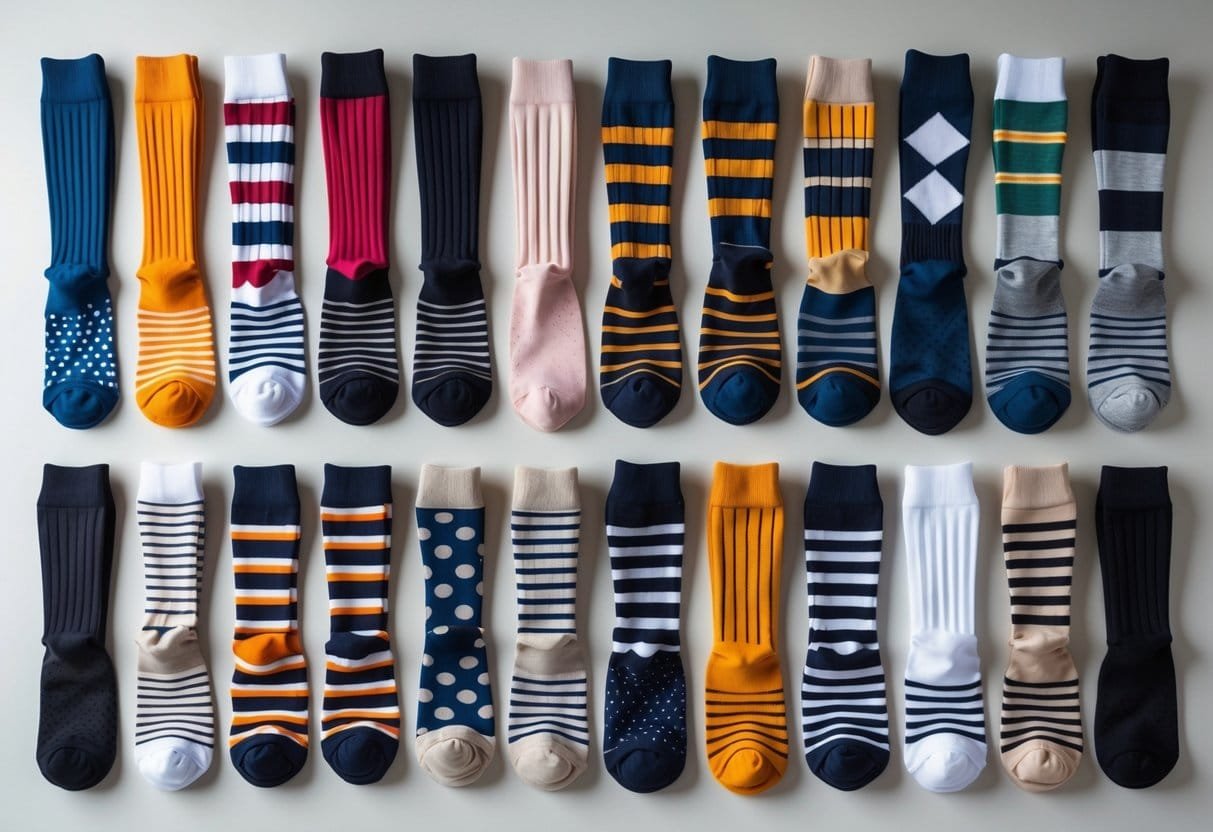
Knee-high socks reach up to just below the knee. They provide extra coverage and warmth compared to shorter socks. Because of their length, they are often chosen for colder weather or when added protection is needed.
These socks work well with boots, keeping legs comfortable and preventing chafing. They are also popular in sports for their support and style. Knee-high socks come in many materials, including cotton, wool, and synthetic blends, to suit different needs.
Fashion uses knee-high socks in uniforms and casual wear. They can add a classic or trendy look depending on the fabric and pattern. Some people wear them for practical reasons, like frostbite protection, while others choose them for style.
Overall, knee-high socks are versatile and serve both functional and aesthetic purposes. Their wide range of uses makes them a common choice for many situations.
7) Thigh-High Socks
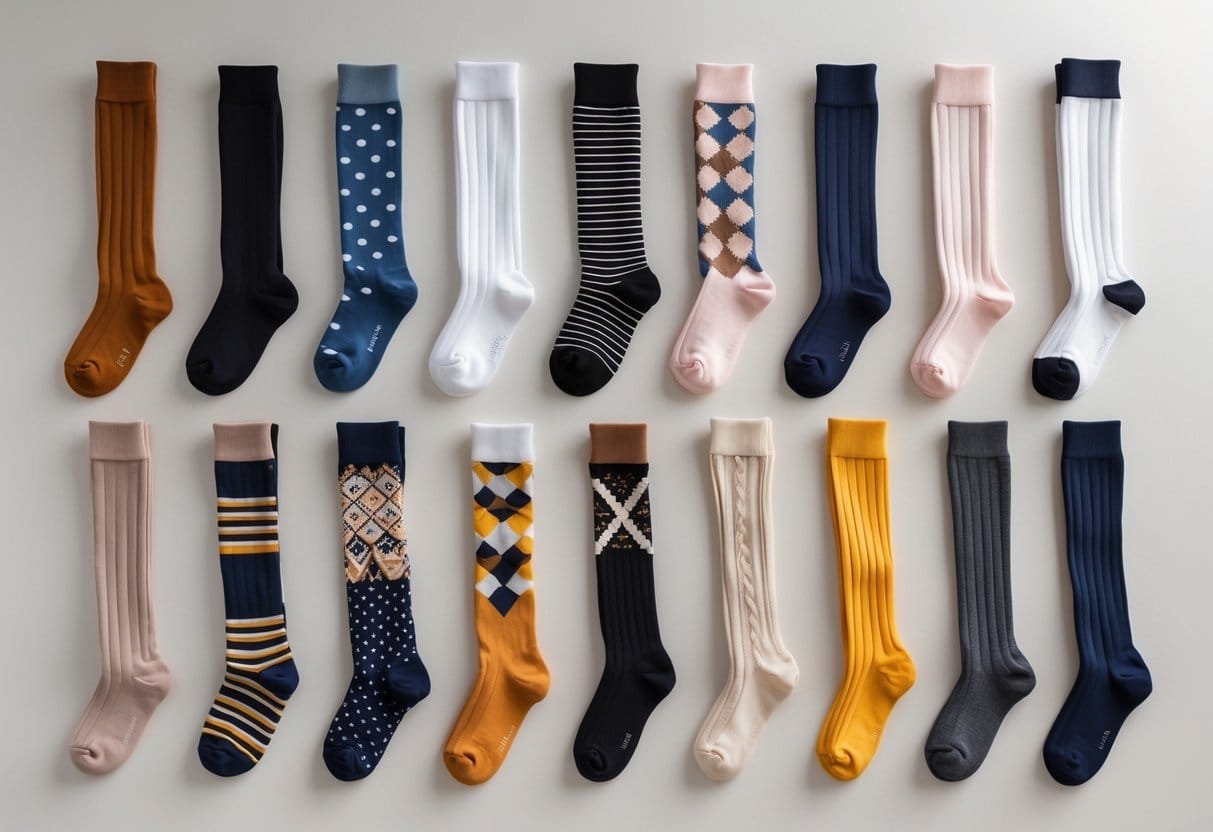
Thigh-high socks are long socks that reach up to the thigh. They offer more coverage than knee-high socks, making them suitable for colder weather or certain fashion styles. These socks often have reinforced toes and heels for added durability.
They are popular in school uniforms, cheerleading, and some sports. Thigh-highs can also be worn for fashion, adding a bold or stylish touch to an outfit. People may choose patterned or solid-colored thigh-highs depending on their look.
Besides style, thigh-high socks can offer warmth and support. They are sometimes made with stretchy materials to stay in place without slipping down. This makes them practical as well as fashionable.
8) Compression Socks
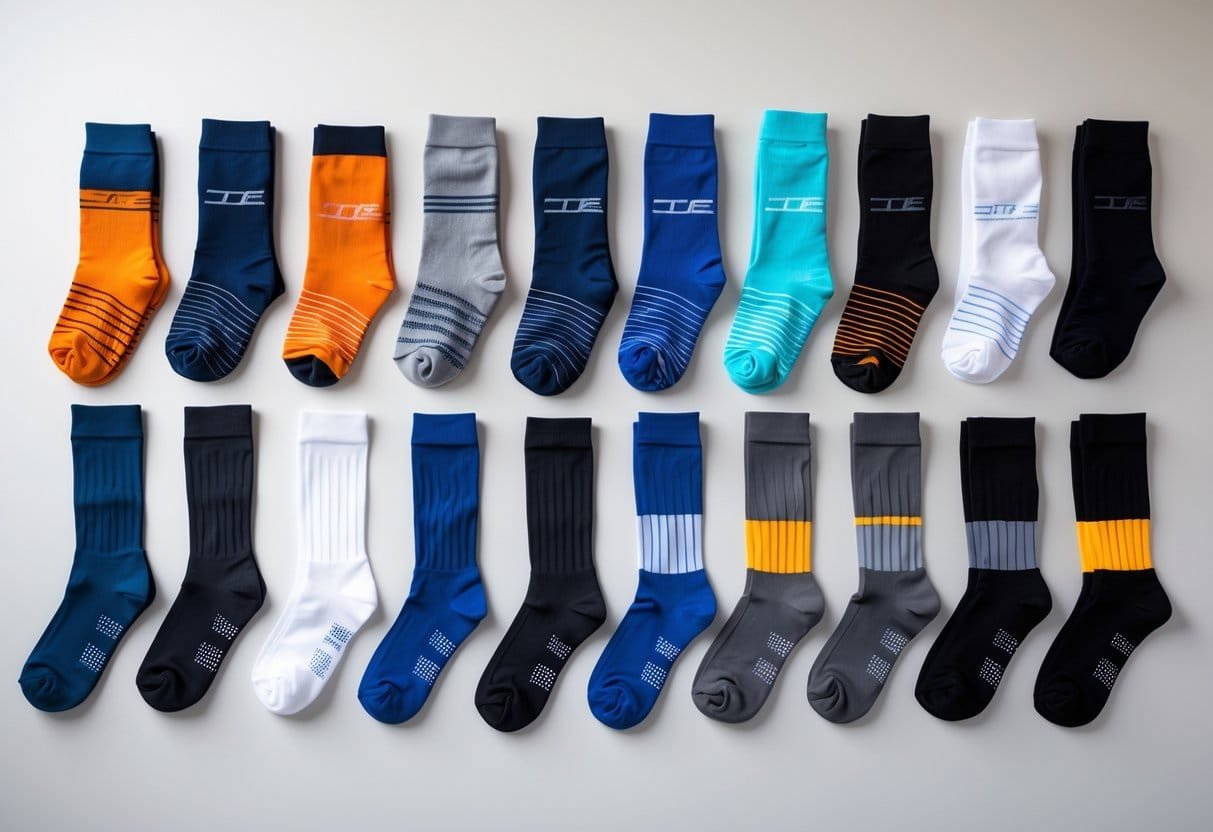
Compression socks are designed to apply pressure to the legs and feet. This pressure helps improve blood flow and reduce swelling. They are often used by people who stand for long periods, athletes, and those with certain medical conditions.
These socks come in different compression levels, measured in millimeters of mercury (mmHg). Lower levels are suitable for everyday use and mild swelling. Higher levels are used under medical supervision for more serious issues like varicose veins or deep vein thrombosis.
Compression socks can be full-length, covering the calf, or sleeves that stop at the ankle. Materials vary but usually include elastic fabrics that provide stretch and support. Wearing the right size is important for comfort and effectiveness.
People use compression socks for various reasons. Some wear them to reduce leg fatigue during travel. Others rely on them for faster recovery after sports or exercise. Doctors may recommend them to improve circulation in specific health cases.
9) Dress Socks
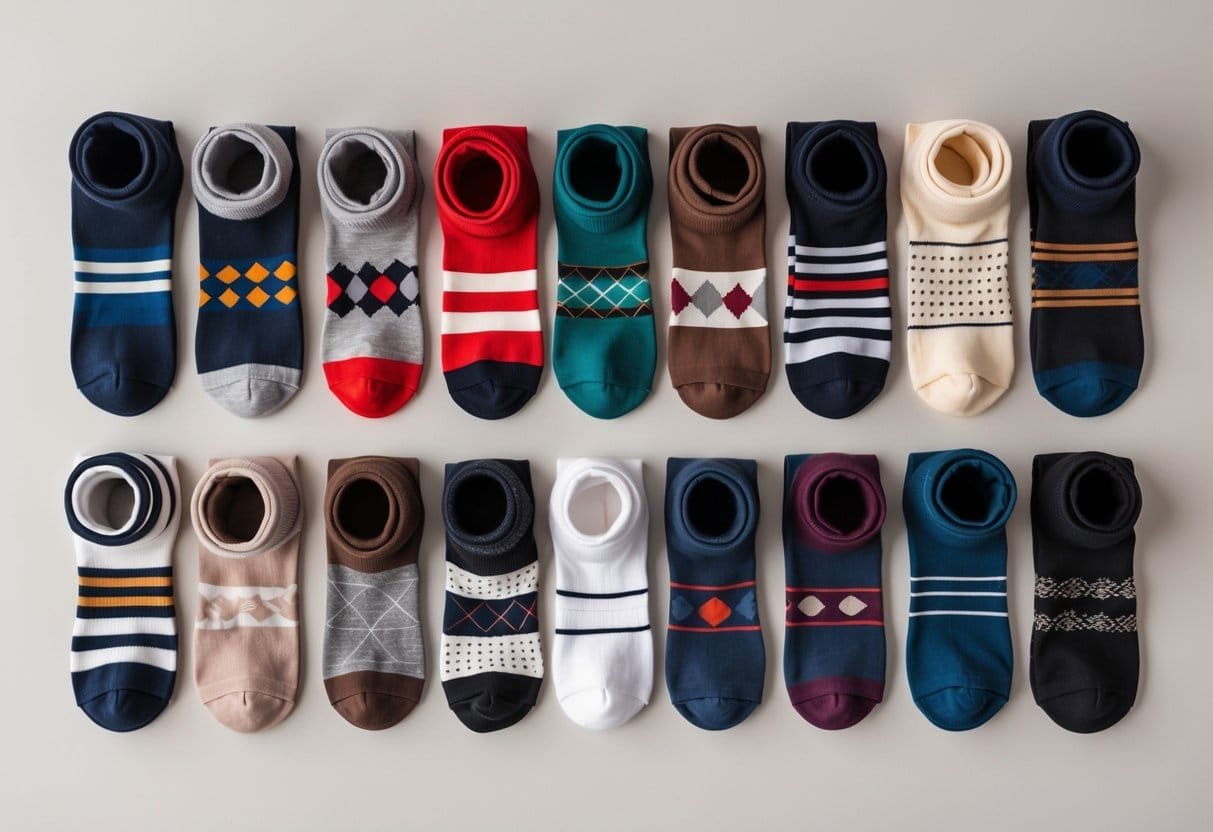
Dress socks are designed to be worn with formal or professional clothing. They are usually thinner than casual socks and fit snugly to give a polished look. Common colors include black, gray, and navy, which match well with dress shoes and suits.
These socks are often made from materials like cotton, wool, or silk. Cotton offers breathability, wool provides warmth and moisture control, and silk adds a smooth, luxurious feel. Each material suits different seasons and occasions.
Dress socks come in various styles, such as solid colors, subtle patterns, or even bold designs for a modern touch. They typically reach mid-calf or higher to ensure they stay hidden under trousers when sitting or moving.
Comfort is important too. Good dress socks balance style with softness and durability. They help reduce friction inside dress shoes, making long days easier on the feet.
10) Athletic Socks
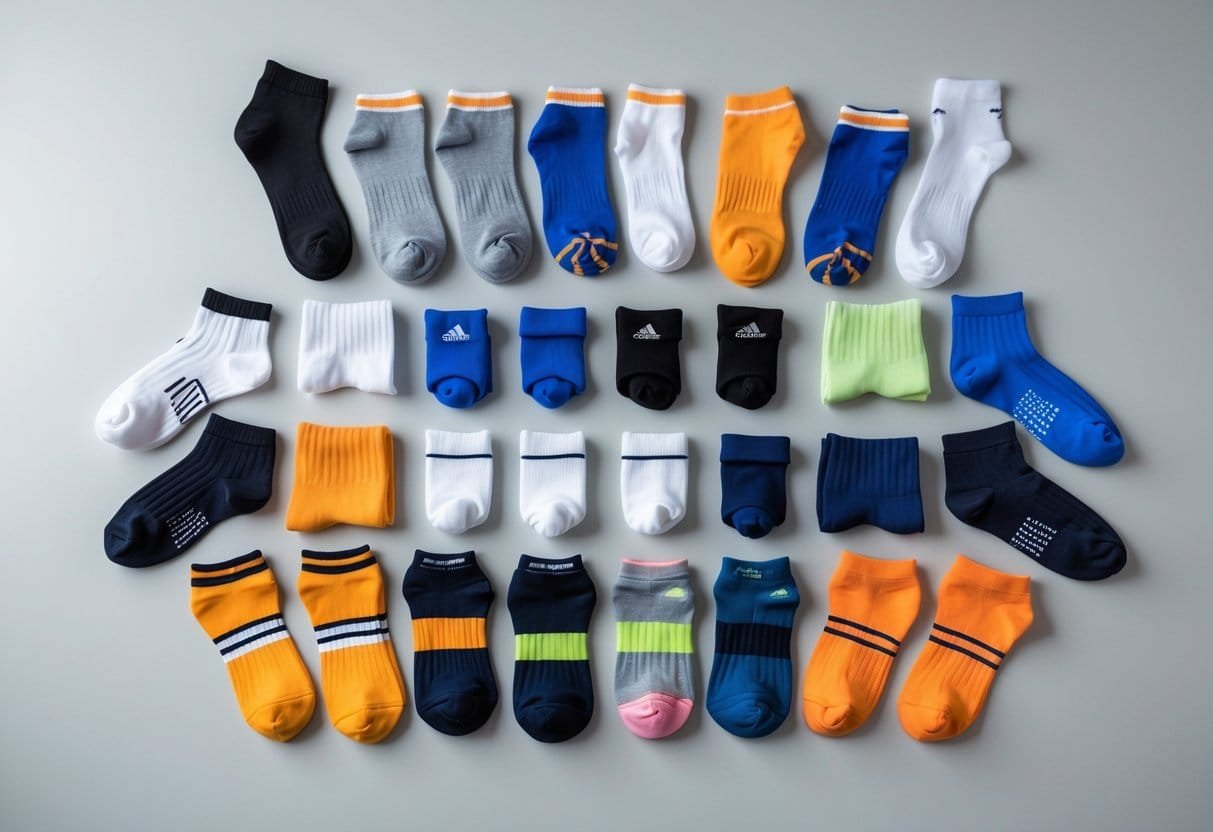
Athletic socks are designed specifically to support physical activity. They often include features like extra cushioning to reduce impact and improve comfort during sports.
These socks usually have moisture-wicking materials. This helps keep feet dry by pulling sweat away, which can prevent blisters and discomfort.
Different sports require different sock styles. For example, running socks might focus on breathability and shock absorption. Meanwhile, compression socks are useful in basketball or soccer because they support circulation and reduce muscle fatigue.
Athletic socks also come in various lengths such as ankle, crew, or knee-high. The choice depends on the sport and personal preference.
Brands often test these socks to ensure durability and performance. Proper athletic socks can help prevent injuries and improve comfort during exercise.
11) Boot Socks

Boot socks are made specifically to be worn with boots. They are usually thicker than regular socks. This extra thickness helps protect the feet from pressure and friction inside the boot.
These socks often reach mid-calf or higher, matching the height of the boot. The taller length provides more coverage and warmth, which is useful in cold weather or outdoor activities.
Boot socks are designed to manage moisture well. They keep feet dry by wicking sweat away, which can prevent blisters and discomfort during long wear.
Materials like wool, especially Merino wool, are common in boot socks because they offer warmth without overheating. Some boot socks also include extra padding for added comfort.
People wear boot socks when hiking, working, or doing other activities that involve wearing boots for long periods. The right boot sock enhances fit and helps reduce foot fatigue.
12) Slipper Socks
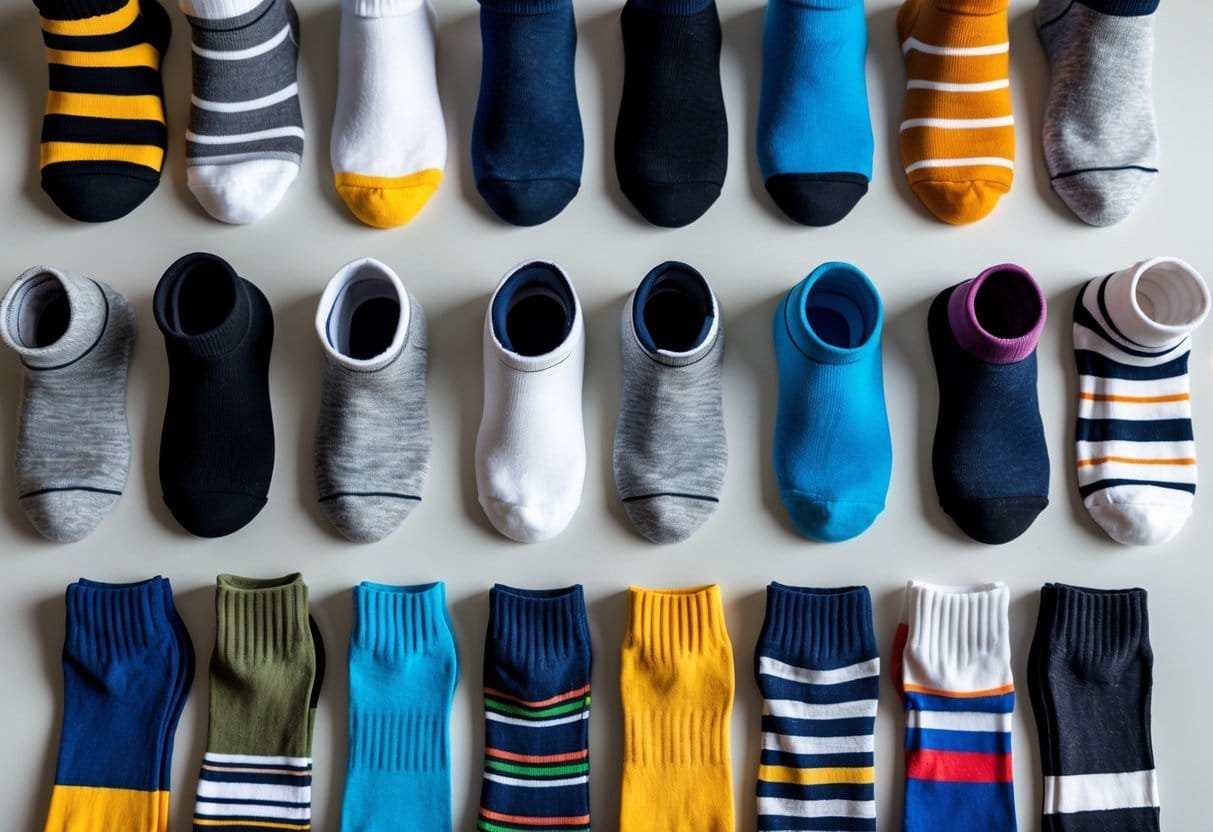
Slipper socks are designed to combine the comfort of regular socks with the safety and warmth of slippers. They usually have a soft, plush lining inside for extra warmth. The bottom often features a non-slip grip made of rubber or silicone, which helps prevent slipping on smooth floors.
These socks are perfect for indoor use, especially during colder months. They provide insulation while allowing easy movement around the house. People use slipper socks to stay cozy without the bulk of traditional slippers.
Slipper socks come in various styles and thicknesses. Some are lightweight and breathable, while others are thick and heavily cushioned. Because of their design, they support both comfort and practicality in daily activities at home.
13) Toe Socks

Toe socks are designed with separate compartments for each toe, similar to gloves for the feet. This design helps keep toes apart, which can reduce friction and prevent blisters during activities like running or hiking.
They offer a unique combination of comfort and breathability. By allowing toes to move independently, toe socks can improve balance and foot alignment. Some people find that this helps with foot health and overall comfort.
Toe socks come in different materials, including cotton, wool, and synthetic blends. This variety makes them suitable for various weather conditions and activities. They can be worn casually or for sports.
Additionally, toe socks can fit well with many shoe types, especially those with a wide toe box. People may choose toe socks to avoid the squishing of toes common with traditional socks. They also come in styles that focus on grip and flexibility.
14) Diabetic Socks
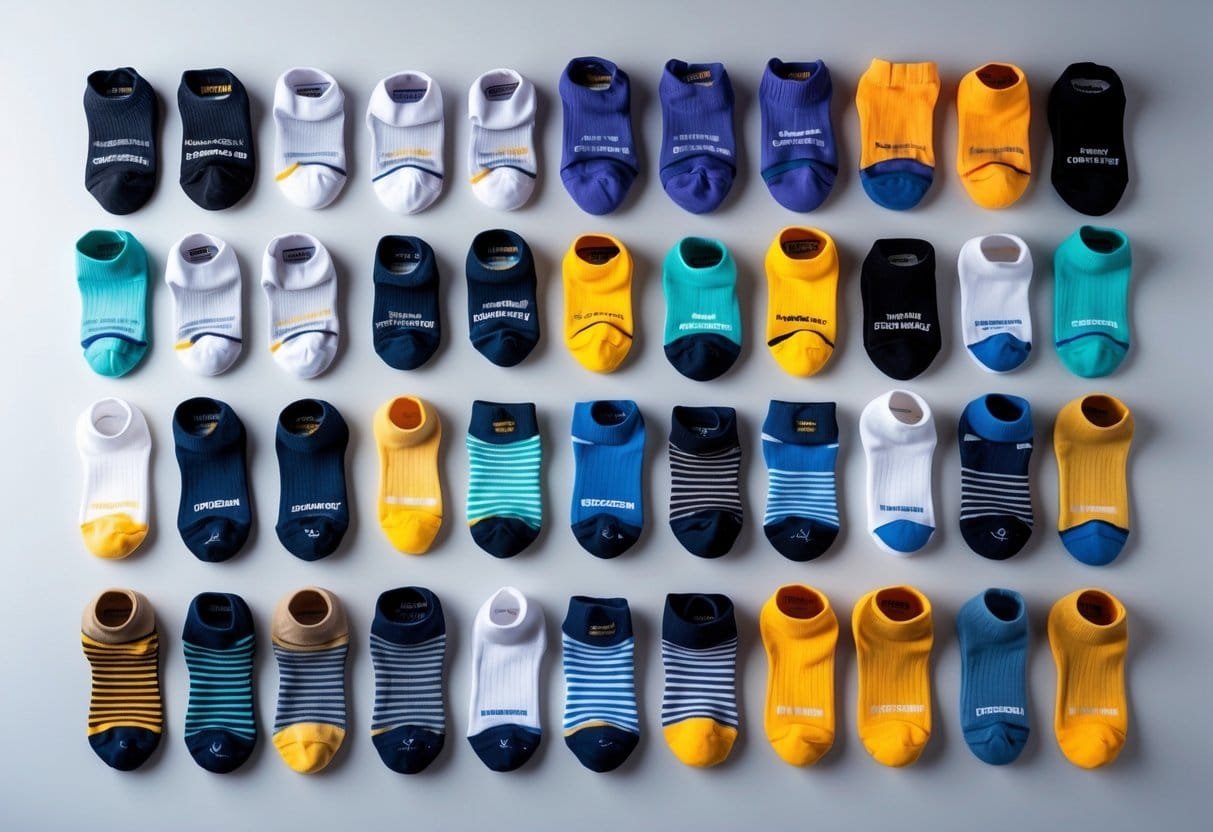
Diabetic socks are designed to protect the feet of people with diabetes. They help reduce the risk of cuts, blisters, and infections by being made from soft, non-irritating materials. These socks often have seamless toes to prevent rubbing and irritation.
They also improve blood circulation with features like gentle compression and non-binding cuffs. This helps lower the chance of swelling and discomfort. Moisture-wicking fabrics keep feet dry, which reduces the risk of fungal infections.
Some diabetic socks include extra cushioning to offer comfort and protect sensitive areas. Others come with antimicrobial treatments to keep feet healthier.
People with diabetes should choose socks that fit well and do not restrict blood flow. Different styles are available for daily wear, sports, and dress occasions. Picking the right pair is an important part of foot care to prevent problems and maintain comfort.
Materials and Their Impact
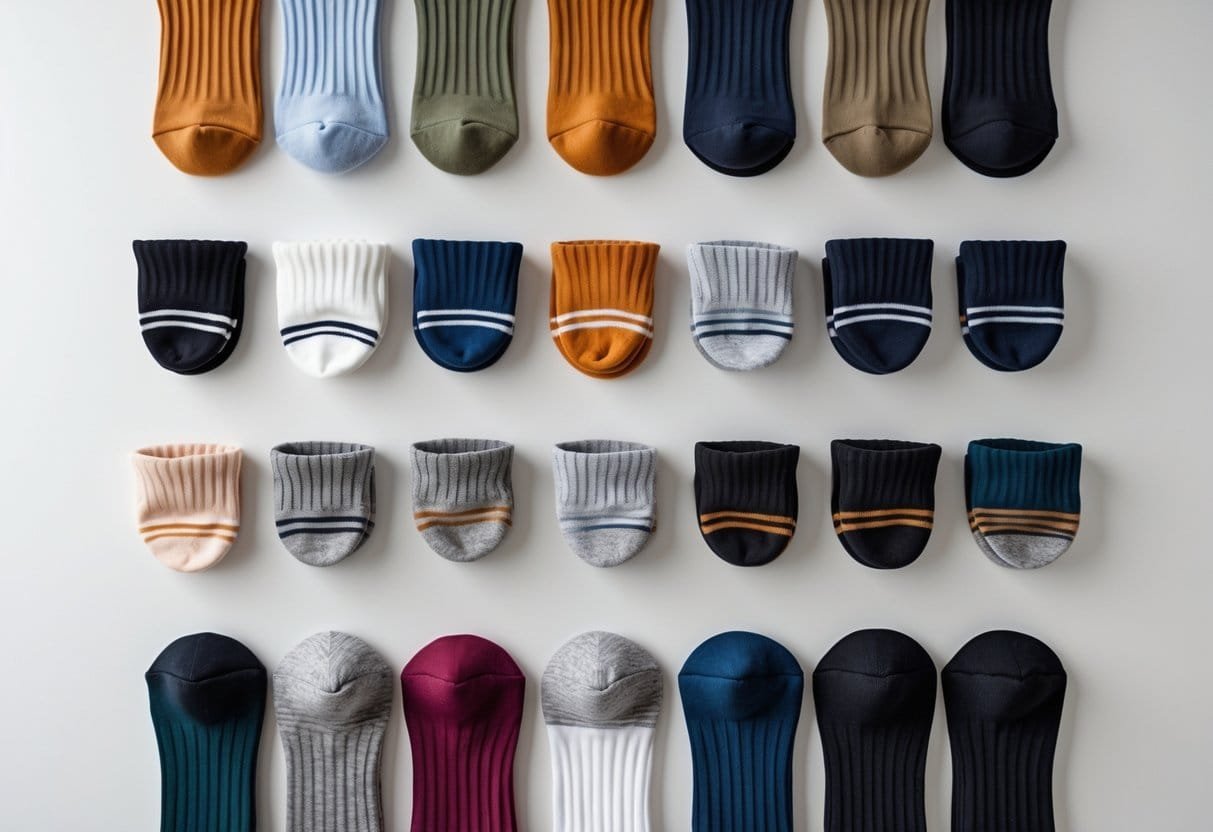
The choice of sock material affects comfort, performance, and longevity. Different fibers serve distinct purposes, from managing moisture to standing up to wear and tear. Understanding these factors helps select the right sock for specific needs.
Natural vs Synthetic Fibers
Natural fibers like cotton, wool, and bamboo come from plants or animals. They offer good breathability and softness, making them comfortable for daily wear. Wool, especially merino, provides excellent temperature control and odor resistance. However, natural fibers tend to absorb moisture, which can sometimes cause dampness.
Synthetic fibers such as polyester, nylon, and acrylic are man-made. They excel in durability and drying speed, often used in athletic socks. These fibers handle moisture better by wicking sweat away from the skin, keeping feet dry during exercise. But synthetic materials may cause irritation for some people and are less environmentally friendly because they do not break down easily.
Moisture Management Technologies
Socks designed for moisture control use blends of materials and special weaves. Synthetic fibers often lead this effort, pulling sweat away from the foot to the sock’s surface where it can evaporate. This reduces blisters and discomfort during activity.
Some socks combine natural fibers like wool with synthetics to balance moisture management and softness. Brands may also use mesh panels or ventilation zones to improve airflow. These features are crucial for athletes, hikers, or anyone wearing socks for long hours to maintain foot health and comfort.
Durability Considerations
Durability depends on fiber strength and sock construction. Synthetic fibers like nylon and polyester strengthen socks and help them keep shape after repeated washes. Cotton, while comfortable, wears out faster and can lose elasticity.
Reinforced areas like heels and toes are important in durable socks. Double stitching or thicker yarns in these spots prevent holes and extend the sock’s life. For heavy use, socks with added synthetic blends or tough fibers like acrylic provide better long-term performance.
Proper Sock Care and Maintenance
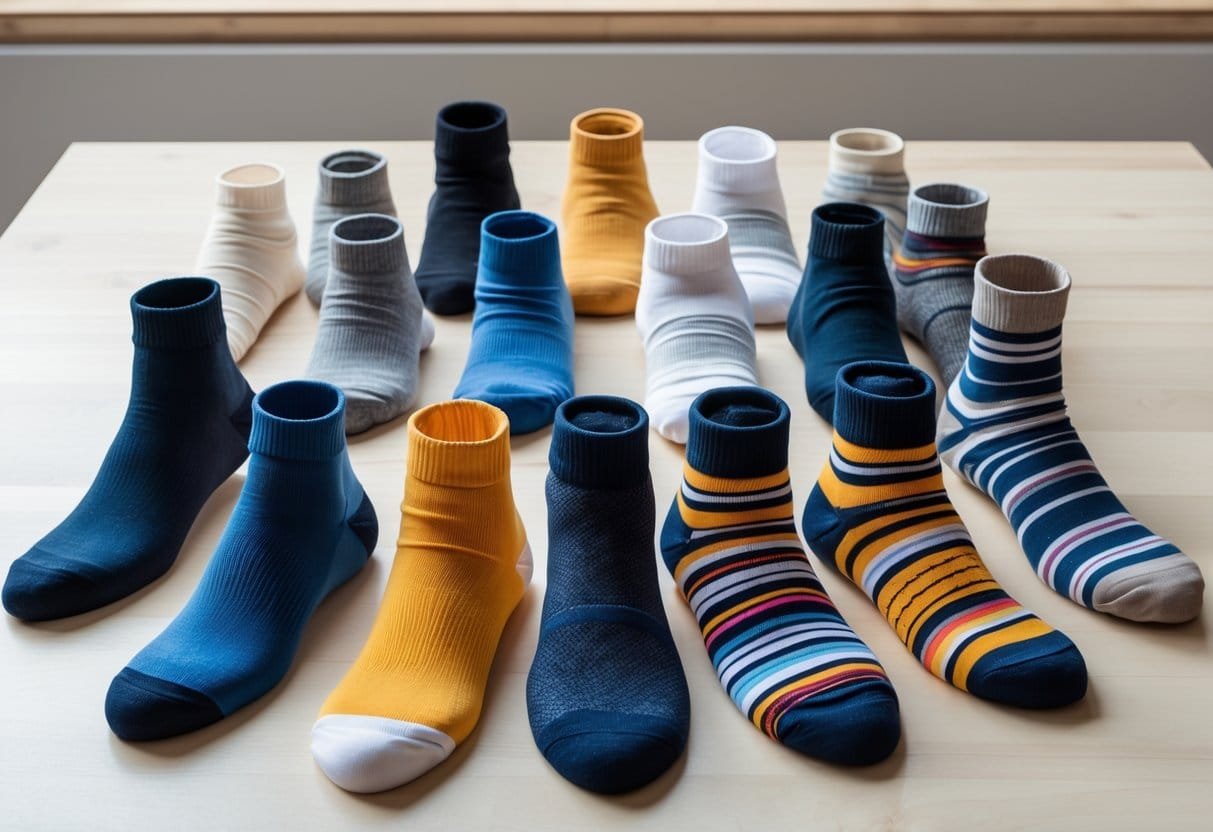
Proper care keeps socks clean, comfortable, and lasting longer. Washing methods and storage habits play a big role in preserving the fabric and shape. Knowing how to handle different materials prevents damage and helps socks stay fresh.
Washing Recommendations
Socks should be washed inside out to protect the fabric and keep colors from fading. Washing similar materials together is important. For example, wool socks need cold water and gentle cycles, while cotton socks can handle warm water.
Avoid using hot water on delicate socks like merino wool. Hot water can shrink or weaken fibers. Use mild detergent and skip bleach, which can break down fabrics.
Overwashing should be avoided because frequent scrubbing and harsh cycles wear socks out faster. Air drying or low heat in the dryer helps maintain elasticity and prevents shrinking.
Storage Best Practices
Socks should be stored flat or gently rolled rather than balling them up. This keeps elastic bands from stretching out and helps socks maintain their shape.
Sorting socks by type before storing can help keep pairs together and easy to find. Avoid cramming socks tightly into drawers, which can damage the fabric.
Keeping socks in a cool, dry place prevents mildew and keeps them smelling fresh. Using drawer dividers or small boxes can improve organization and protect socks from damage.
Frequently Asked Questions
Socks differ by fit, length, style, material, and use. Choosing the right type depends on factors such as gender, activity, and occasion. Various designs serve specific functions from casual wear to athletic performance.
What are the differences between men’s and women’s socks?
Men’s socks are generally larger with a wider fit and a longer foot length. Women’s socks often have narrower heels and are trimmed to fit smaller shoe sizes.
Color and style choices may also vary, with women’s socks sometimes offering more patterns and varied heights. However, many socks are unisex and focus on size rather than gender.
What are the main categories of sock lengths?
The most common sock lengths include no-show, ankle, crew, mid-calf, and over-the-calf. No-show socks sit below the shoe line for a hidden look.
Ankle socks cover the ankle bone, while crew socks reach about six inches above the ankle. Mid-calf socks go halfway up the calf, and over-the-calf socks extend near the knee.
How do sock styles vary for different occasions or purposes?
Dress socks are thinner, made from finer materials, and designed to complement formal wear. Athletic socks often include extra cushioning and moisture-wicking features.
Casual socks focus on comfort and style with varied colors and patterns. Compression socks improve circulation for medical or athletic use. Slipper socks are soft with grips for indoor wear.
What should be considered when choosing socks for specific activities?
For running or hiking, socks with moisture control and padding help prevent blisters. Compression socks are recommended for long flights or circulation issues.
Dress socks require a sleek, thin design to fit well with formal shoes. Work socks often emphasize durability and support. The right fit and breathable material matter most.
Can you explain the unique features of Japanese style socks?
Japanese socks, such as tabi, have a split toe design separating the big toe from the others. This allows wearing them with traditional sandals.
Tabi socks often come up to the ankle or higher and combine cultural style with practical foot flexibility. They are popular both in traditional and modern fashion.
What materials are commonly used in the production of various sock types?
Cotton is popular for everyday socks because it’s breathable and soft but may hold moisture. Wool, especially merino wool, offers warmth and moisture-wicking.
Synthetic fibers like nylon, polyester, and spandex provide stretch, durability, and help with fit. Bamboo and other natural fibers can fight odor and add softness.


